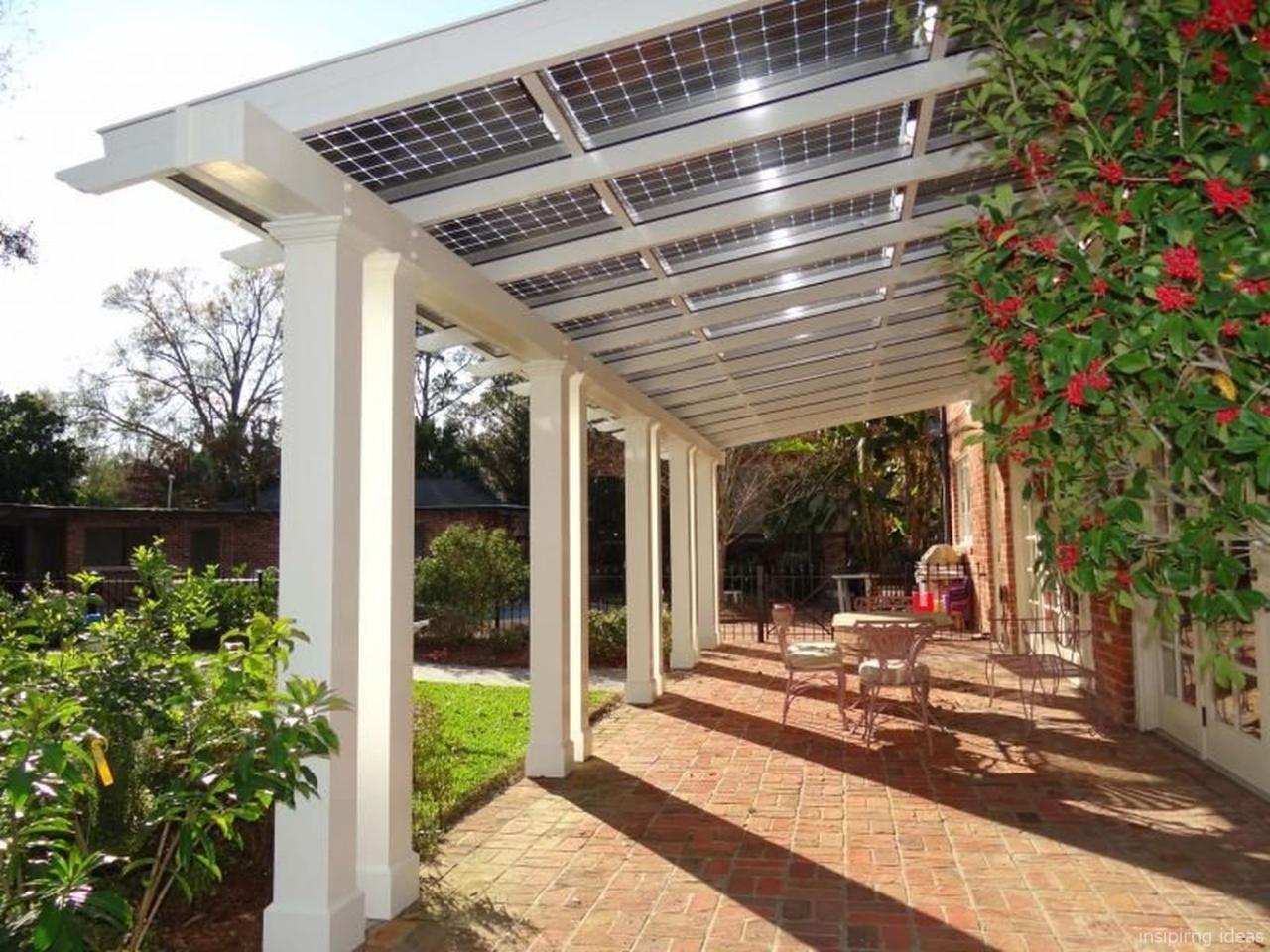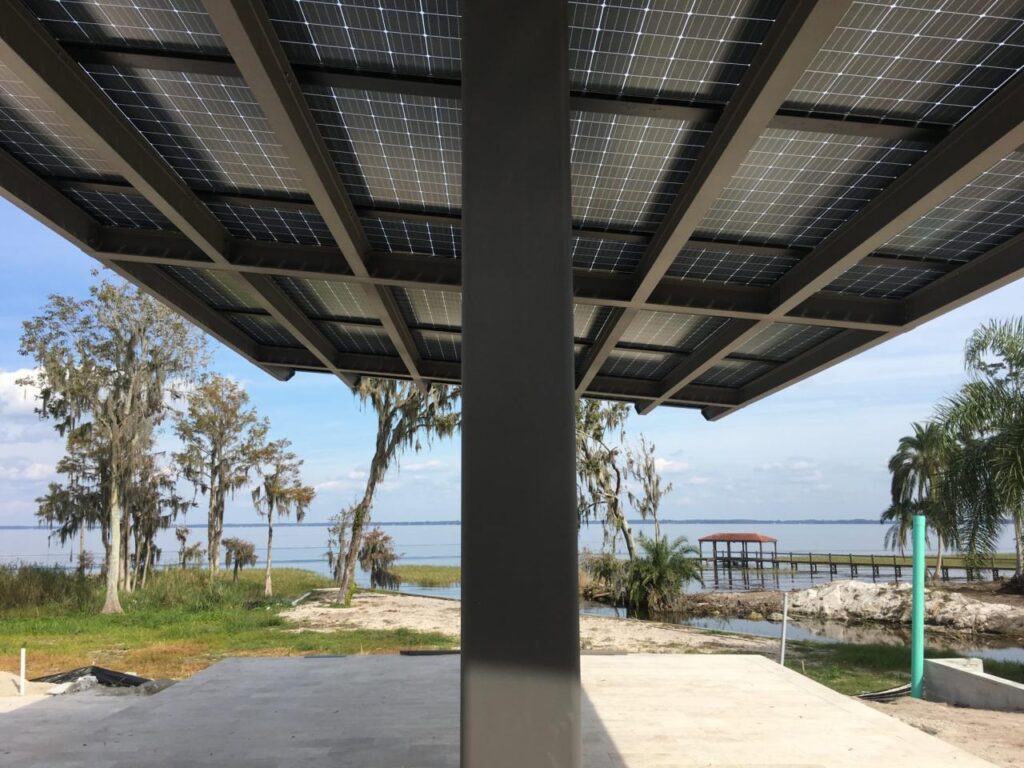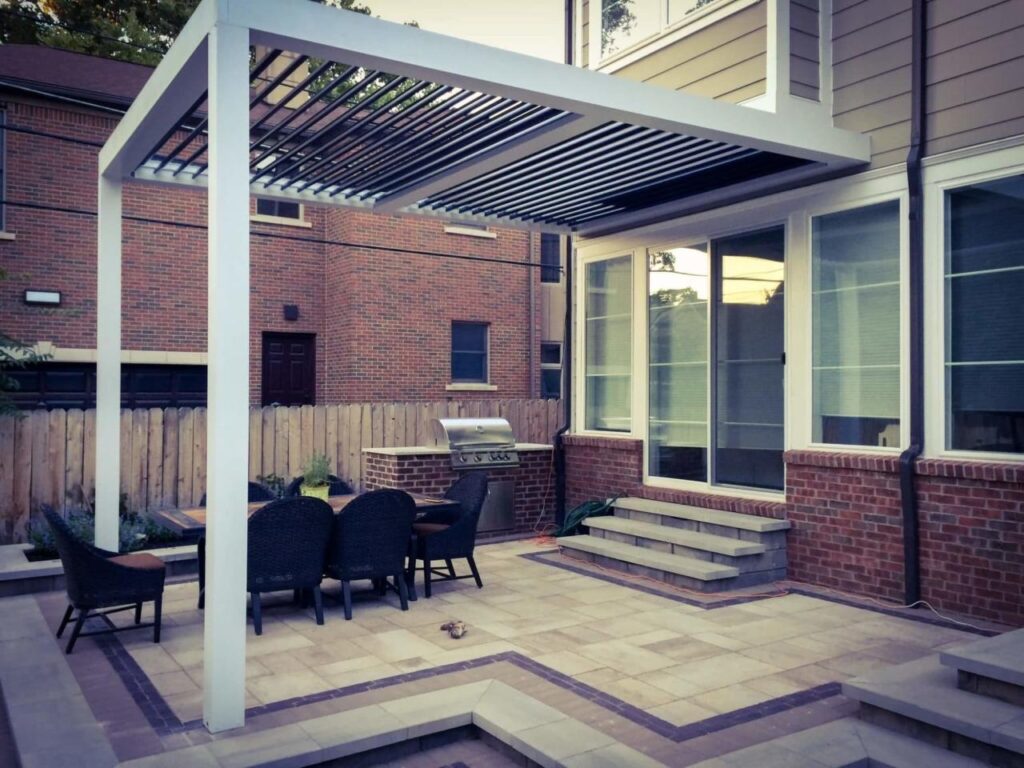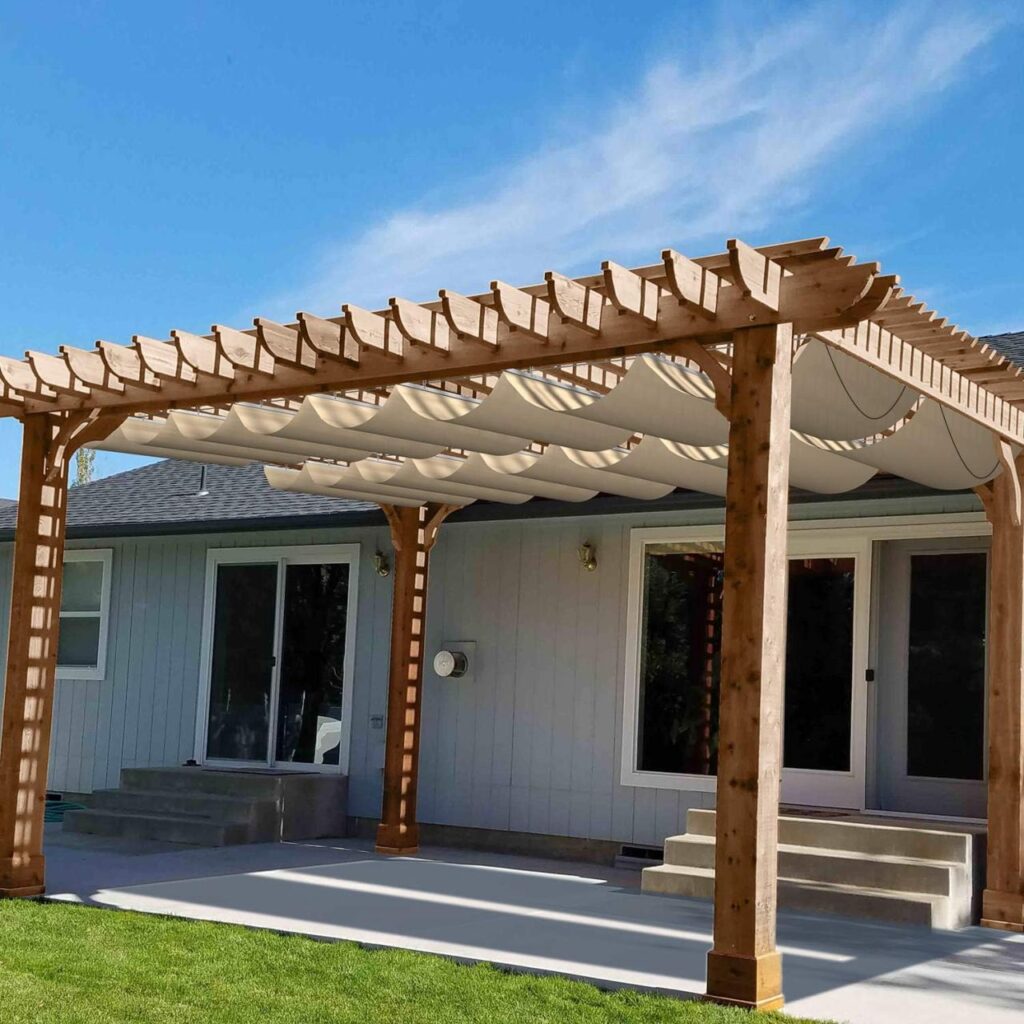Step into the realm of solar on pergola, where sustainability and style intertwine to create a harmonious outdoor haven. This captivating concept seamlessly integrates solar energy into the architectural beauty of pergolas, offering a myriad of benefits that redefine outdoor living.
Imagine a pergola adorned with sleek solar panels, silently harnessing the sun’s rays to power your home and reduce your carbon footprint. As the sun casts its golden glow upon your pergola, you’ll bask in the ambiance of a sun-kissed retreat while contributing to a greener future.
Solar Energy Benefits
Harnessing the sun’s boundless energy for your pergola offers a myriad of advantages, both financial and environmental.
Solar panels convert sunlight into electricity, reducing your reliance on traditional energy sources and potentially slashing your energy bills. By generating your own clean energy, you can significantly lower your carbon footprint and contribute to a greener planet.
Reduced Energy Costs
- Solar panels produce electricity at no additional cost once installed, leading to substantial savings on energy bills over time.
- Excess solar energy can be stored in batteries for use during peak hours or at night, further reducing your dependence on the grid.
Environmental Impact
- Solar energy is a renewable and sustainable source, reducing greenhouse gas emissions and contributing to the fight against climate change.
- By choosing solar, you support clean energy initiatives and promote a healthier environment for generations to come.
Pergola Design Considerations
When designing a pergola for solar panels, it’s crucial to consider the type, size, and shape to optimize solar exposure and overall efficiency.
Types of Pergolas Suitable for Solar Panels
- Freestanding pergolas: Stand alone structures with no attached walls, offering flexibility in placement and optimal sun exposure.
- Attached pergolas: Connected to a building or structure, providing shade and support for solar panels.
- Arbors: Similar to pergolas but typically smaller and arched, offering limited but focused solar exposure.
Choosing the Right Size and Shape
The size and shape of the pergola should be carefully planned to maximize solar exposure. Consider the following factors:
- Solar panel size: Determine the size and quantity of solar panels you plan to install to calculate the required pergola area.
- Sun exposure: Analyze the sun’s path throughout the day to determine the optimal orientation and tilt angle for maximum sunlight capture.
- Roof pitch: The angle of the pergola roof affects solar panel efficiency; a steeper pitch allows for better sun exposure but may require additional support.
- Aesthetic considerations: The pergola should complement the surrounding landscape and architectural style while ensuring it doesn’t obstruct the view.
Solar Panel Installation: Solar On Pergola
Installing solar panels on a pergola involves several steps. First, the pergola’s structure must be assessed to ensure it can support the weight of the panels and withstand the elements.
Once the structural integrity is confirmed, the mounting system for the solar panels is selected. Common options include roof-mounted systems, ground-mounted systems, and pole-mounted systems. Each system has its own advantages and disadvantages, so it’s important to choose the one that best suits the specific pergola and location.
Securing the Installation
To ensure a secure installation, it’s essential to follow the manufacturer’s instructions carefully. The mounting system should be securely attached to the pergola, and the solar panels should be properly aligned and fastened to the mounting system.
In addition, the electrical connections between the solar panels and the inverter should be made according to the manufacturer’s specifications. Proper wiring and grounding are crucial for the safe and efficient operation of the solar system.
Electrical Wiring and Connections
Installing a solar pergola requires careful planning and execution when it comes to electrical wiring and connections. To ensure a safe and efficient system, it’s crucial to adhere to specific requirements and select the right components.
Electrical Wiring Requirements
- Conduit: Solar panels should be connected using a conduit, which is a protective pipe that houses the electrical wires. This protects the wires from damage and ensures a neat installation.
- Wiring Gauge: The thickness of the electrical wires used will depend on the power output of the solar panels. A larger wire gauge indicates a thicker wire, which can handle higher current.
- Grounding: Proper grounding is essential for safety. The solar panel system should be connected to a grounding rod, which provides a path for excess electricity to dissipate safely.
Choosing the Right Inverter and Components
An inverter is a critical component that converts the DC electricity generated by the solar panels into AC electricity, which is compatible with the electrical grid. When selecting an inverter, consider factors such as the power output of the solar panels, the voltage of the electrical grid, and the efficiency of the inverter.
In addition to the inverter, other electrical components may be needed, such as a charge controller, which regulates the flow of electricity from the solar panels to the batteries, and a monitoring system, which allows you to track the performance of the solar pergola.
Maintenance and Monitoring
Maintaining your solar pergola system is crucial to ensure optimal performance and longevity. Regular cleaning, inspections, and monitoring can help identify and resolve any issues promptly.
Monitoring your solar system’s performance is equally important. By tracking energy production and comparing it to expected output, you can identify any discrepancies that may indicate a problem.
Cleaning
Solar panels should be cleaned regularly, especially after heavy rain or dust storms. Dirt and debris can accumulate on the panels, reducing their efficiency. Use a soft brush or cloth with water to gently remove any buildup.
Inspections
Periodic inspections are essential to detect any physical damage or loose connections. Check for cracks, broken cells, or loose wiring. Prompt repairs can prevent further damage and ensure the system operates safely and efficiently.
Case Studies and Examples
Numerous successful solar pergola installations exist, showcasing the practical and aesthetic benefits of integrating solar energy into outdoor living spaces.
These case studies offer valuable insights into the design, installation, and performance of solar pergolas, demonstrating their potential to enhance sustainability, reduce energy costs, and create comfortable outdoor environments.
Residential Solar Pergola
A suburban homeowner in California installed a solar pergola over their backyard patio. The pergola features a latticework of solar panels that provide shade and generate electricity.
Envision your pergola adorned with solar panels, transforming it into a radiant energy hub. Its sturdy wood frame, wood pergola with roof , provides ample support for the panels, while the open design allows for optimal sunlight exposure. With solar on pergola, you’ll harness nature’s bounty to power your home, creating a sustainable oasis beneath the dappled shade.
The system generates approximately 50% of the household’s electricity needs, significantly reducing their utility bills and carbon footprint.
Commercial Solar Pergola
A restaurant in Florida installed a solar pergola over its outdoor dining area. The pergola provides shade for customers while generating electricity to power the restaurant’s lighting and appliances.
With solar on pergola, you can extend your outdoor living space and enjoy the great outdoors even longer. Add a touch of relaxation with pergola swings , where you can sway gently in the breeze while soaking up the sun.
The combination of solar lighting and pergola swings creates a cozy and inviting atmosphere, making your pergola the perfect place to unwind and escape the hustle and bustle of everyday life.
The system has reduced the restaurant’s energy costs by 30%, making it a financially viable investment that enhances the dining experience for customers.
Community Solar Pergola
A community center in Texas installed a solar pergola in its park. The pergola provides a shaded gathering space for community events while generating electricity that powers the center’s facilities.
The system fosters a sense of community, promotes sustainability, and reduces the center’s operating expenses.
Harnessing the sun’s power through solar on pergola can transform your outdoor space into an energy-efficient haven. To enhance its functionality, consider pairing it with a canvas pergola shade. This versatile shade provides adjustable protection from the sun’s glare while allowing ample natural light to filter through, creating a comfortable and inviting ambiance.
The integration of solar on pergola and canvas pergola shade elevates your outdoor living experience, allowing you to enjoy the sun’s benefits without compromising comfort.
Design Ideas and Inspiration
Unleash your creativity with these inspiring design ideas for pergolas that seamlessly blend solar technology with aesthetics. From sleek and modern to rustic and charming, these examples will help you craft a solar-powered pergola that enhances both the functionality and beauty of your outdoor space.
By integrating solar panels into the pergola’s design, you can create a self-sustaining structure that generates clean energy while providing shade and protection from the elements. Here are some design considerations to keep in mind:
Placement and Orientation, Solar on pergola
- Position the solar panels on the pergola’s roof or on adjustable mounts to optimize sun exposure throughout the day.
- Consider the angle and orientation of the panels to maximize energy production based on your geographic location.
Aesthetics and Integration
- Choose solar panels with a color or finish that complements the pergola’s design, blending seamlessly with the overall aesthetic.
- Incorporate the solar panels into the pergola’s structure, using them as a decorative element or as a functional part of the roof.
Landscaping and Surroundings
- Create a cohesive outdoor space by planting vegetation around the pergola that complements the solar panels’ color and texture.
- Consider the overall landscaping design to ensure the pergola with solar panels integrates harmoniously with the surrounding environment.
Examples of Inspiring Designs
- A modern pergola with a flat roof covered in sleek black solar panels, creating a clean and contemporary look.
- A rustic pergola with a pitched roof featuring terracotta-colored solar panels, blending seamlessly with the natural surroundings.
- A pergola with a curved roof made of translucent solar panels, allowing natural light to filter through while generating energy.
These design ideas will inspire you to create a solar-powered pergola that is both functional and aesthetically pleasing, adding value and beauty to your outdoor living space.
Cost and ROI
Installing a solar pergola involves upfront costs, but it can provide significant long-term financial benefits. The cost of a solar pergola varies depending on factors such as the size, design, and materials used. Generally, a basic solar pergola can cost around $10,000 to $20,000, while more elaborate designs can cost upwards of $50,000.
Potential financial incentives, such as tax credits and rebates, can help offset the initial investment. The federal government offers a 30% tax credit for the installation of solar energy systems, including solar pergolas. Additionally, many states and local governments offer their own incentives, such as rebates or property tax exemptions.
The return on investment (ROI) for a solar pergola depends on several factors, including the cost of electricity in your area, the amount of sunlight your pergola receives, and the efficiency of your solar panels. In general, solar pergolas can provide a 10-15% ROI over 20-25 years.
Final Thoughts
Solar on pergola is more than just an energy-saving solution; it’s a statement of sustainable living and an embodiment of architectural ingenuity. By embracing this innovative concept, you not only reduce your environmental impact but also create a captivating outdoor space that inspires awe and admiration. As the sun continues its celestial journey, your solar pergola will stand as a testament to your commitment to sustainability and your appreciation for the beauty of nature.









